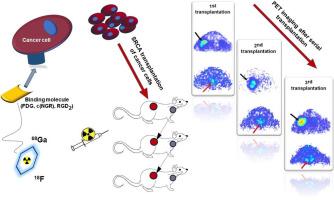转移和血管生成:肝细胞癌(He/De)肿瘤模型的临床前PET研究。
IF 4.7
3区 医学
Q1 PHARMACOLOGY & PHARMACY
引用次数: 0
摘要
利用动物模型研究肿瘤发生和转移扩散似乎对于发现抑制肿瘤发展和进展的新的诊断和治疗靶点至关重要。本研究建立了肝细胞癌(He/De)的临床前转移模型,利用正电子发射断层扫描(PET)和血管生成特异性放射性药物探索转移形成和相关血管生成过程。在fisher -344大鼠肾下囊法产生原发性、继发性和第三期移植转移性He/De肿瘤约8±1天后,我们使用[18F]FDG、[68Ga]Ga-NOTA-c(NGR)和[68Ga]Ga-NODAGA-[c(RGD)]2进行肿瘤发展和血管生成的体内PET成像。[18F]FDG在所有被调查的示踪剂中显示出最高的放射性水平。这种模式在三例移植的所有肿瘤病变中都是一致的。对比两种68ga标记探针,NGR化合物在肾下生长的原发性/继发性/三期He/De肿瘤和相关甲状旁淋巴结转移瘤(ptln, p≤0.01)中的积累量显著增加(p≤0.05),这可能表明氨基肽酶N/CD13的表达水平高于rgd结合αvβ3整合素的表达水平。在连续移植过程中,肾下生长的He/De肿瘤和ptln的[18F]FDG、[68Ga]Ga-NOTA-c(NGR)和[68Ga]Ga-NODAGA-[c(RGD)]2摄取的逐渐增加可能意味着侵袭性增加。总的来说,目前开发的实验系统为进一步研究转移性扩散提供了一个可行的平台。本文章由计算机程序翻译,如有差异,请以英文原文为准。

Metastasis and angiogenesis: preclinical PET study on hepatocellular carcinoma (He/De) tumor models
The use of animal models to study tumorigenesis and metastatic spread seems crucial to discover novel diagnostic and therapeutic targets that inhibit tumor development and progression. In this study a preclinical metastasis model of hepatocellular carcinoma (He/De) was established to explore metastases formation and related angiogenic processes using positron emission tomography (PET) and angiogenesis specific radiopharmaceuticals. Approximately 8 ± 1 days after the subrenal capsule assay-based generation of the primary, secondary and tertiary transplanted metastatic He/De tumors in Fischer-344 rats, we used [18F]FDG, [68Ga]Ga-NOTA-c(NGR) and [68Ga]Ga-NODAGA-[c(RGD)]2 for the in vivo PET imaging of tumor development and angiogenesis. [18F]FDG displayed the highest level of radioactivity among all investigated tracers. This pattern was consistent across all neoplastic lesions in each of the three transplantations. Comparing the two 68Ga-labelled probes, the NGR compound showed significantly higher accumulation in the subrenally growing primary/secondary/tertiary He/De tumors (p ≤ 0.05) and related parathymic lymph node metastases (PTLNs, p ≤ 0.01) that could indicate higher expression level for aminopeptidase N/CD13 than for RGD-binding αvβ3 integrin. Progressive increase in the [18F]FDG, [68Ga]Ga-NOTA-c(NGR) and [68Ga]Ga-NODAGA-[c(RGD)]2 uptakes of both the subrenally growing He/De tumors and the PTLNs during the serial transplantations may imply increasing aggressivity. Overall, the currently developed experimental system provides a feasible platform for further investigation of metastatic spread.
求助全文
通过发布文献求助,成功后即可免费获取论文全文。
去求助
来源期刊
CiteScore
9.60
自引率
2.20%
发文量
248
审稿时长
50 days
期刊介绍:
The journal publishes research articles, review articles and scientific commentaries on all aspects of the pharmaceutical sciences with emphasis on conceptual novelty and scientific quality. The Editors welcome articles in this multidisciplinary field, with a focus on topics relevant for drug discovery and development.
More specifically, the Journal publishes reports on medicinal chemistry, pharmacology, drug absorption and metabolism, pharmacokinetics and pharmacodynamics, pharmaceutical and biomedical analysis, drug delivery (including gene delivery), drug targeting, pharmaceutical technology, pharmaceutical biotechnology and clinical drug evaluation. The journal will typically not give priority to manuscripts focusing primarily on organic synthesis, natural products, adaptation of analytical approaches, or discussions pertaining to drug policy making.
Scientific commentaries and review articles are generally by invitation only or by consent of the Editors. Proceedings of scientific meetings may be published as special issues or supplements to the Journal.

 求助内容:
求助内容: 应助结果提醒方式:
应助结果提醒方式:


